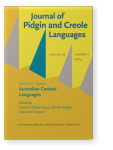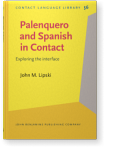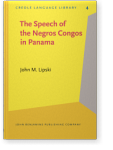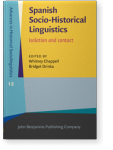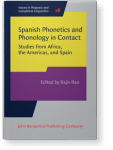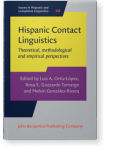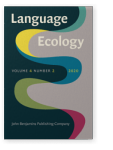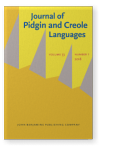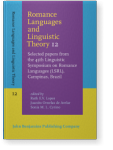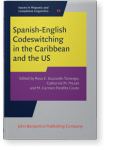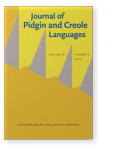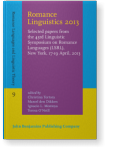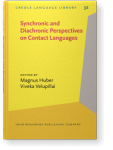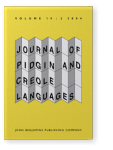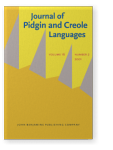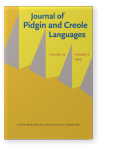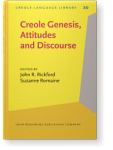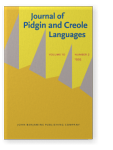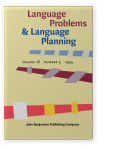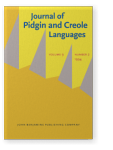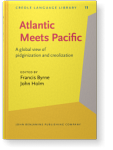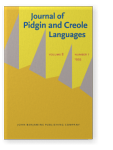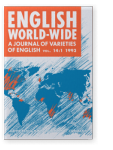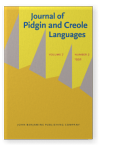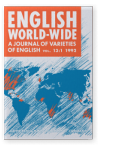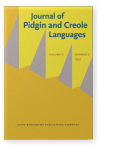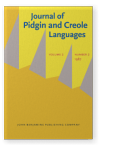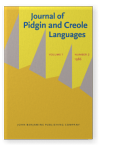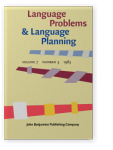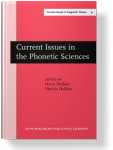John M. Lipski
List of John Benjamins publications for which John M. Lipski plays a role.
Journal
Book series
Titles
Palenquero and Spanish in Contact: Exploring the interface
John M. Lipski
[Contact Language Library, 56] 2020. xvii, 318 pp.
Subjects Contact Linguistics | Creole studies | Multilingualism | Romance linguistics
The Speech of the Negros Congos in Panama
John M. Lipski
[Creole Language Library, 4] 1989. vii, 159 pp.
Subjects Contact Linguistics | Creole studies | Romance linguistics | Sociolinguistics and Dialectology
2021 Searching for the sociolinguistic history of Afro-Panamanian Congo speech Spanish Socio-Historical Linguistics: Isolation and contact, Chappell, Whitney and Bridget Drinka (eds.), pp. 141–162 | Chapter
Among the surviving Afro-Hispanic linguistic manifestations, one of the most difficult to trace historically is the speech of the Congos of Panama’s Caribbean coast, who maintain a series of folkloric manifestations occurring during Carnival season that includes a special language. According to… read more
2020 Chapter 1. Equatorial Guinea Spanish non-continuant /d/: More than a generic L2 trait Spanish Phonetics and Phonology in Contact: Studies from Africa, the Americas, and Spain, Rao, Rajiv (ed.), pp. 13–32 | Chapter
In Equatorial Guinea, the only sub-Saharan African nation in which Spanish is widely spoken, prevocalic /d/ frequently receives a short occlusive articulation that approximates [ɾ]. A similar pronunciation occurs in some contemporary Afro-descendant populations in Latin America, and Afro-Hispanic… read more
2020 What you hear is (not always) what you get: Subjects and verbs among receptive Palenquero-Spanish bilinguals Mental representations in receptive multilingualism, Holmes, Bonnie C. and Michael T. Putnam (eds.), pp. 315–350 | Article
The present study offers data from native Spanish speakers who possess receptive competence in Palenquero, a Spanish-lexified creole spoken in the Afro-Colombian village of San Basilio de Palenque. Until recently Palenquero was endangered, but language revitalization activities are now underway… read more
2020 Chapter 10. Portuguese-Spanish contacts in Misiones, Argentina: Probing (for) code-switching constraints Hispanic Contact Linguistics: Theoretical, methodological and empirical perspectives, Ortiz López, Luis A., Rosa E. Guzzardo Tamargo and Melvin González-Rivera (eds.), pp. 235–260 | Chapter
The present study reports on spontaneous Portuguese-Spanish mixing as produced by L2 and balanced bilinguals in various communities along the Brazilian border, as well as three interactive tasks conducted with fluent bilinguals in Misiones province, Argentina. Taken together the results reveal a… read more
2020 Can a bilingual lexicon be sustained by phonotactics alone? Evidence from Ecuadoran Quichua and Media Lengua The Mental Lexicon 15:2, pp. 330–365 | Article
This study focuses on bilingual speakers of Ecuadoran Quichua and the mixed language known as Media Lengua, which consists of Quichua morphosyntactic frames with all content word roots relexified from Spanish. For all intents and purposes, only the lexicon – more specifically, lexical roots –… read more
2020 A tale of two lexical-decision tasks: The reality of taking the lab to the field Language Ecology 4:2, pp. 175–201 | Article
As a probe into the degree of integration of the bilingual lexicon, a series of lexical-decision tasks was carried out in two bilingual speech communities with greatly differing linguistic, cultural, and socio-historical characteristics: Misiones province in northeastern Argentina… read more
2019 Chapter 5. Spanish and Palenquero: Language identification through phonological correspondences Recent Advances in the Study of Spanish Sociophonetic Perception, Chappell, Whitney (ed.), pp. 153–186 | Chapter
The Afro-Colombian creole language Palenquero, spoken in the village of San Basilio de Palenque, has been in contact with its historical lexifier, Spanish, for several centuries. The lexicons of the two languages are more than 90% cognate, including complete identity (based on the local vernacular… read more
2017 Chapter 9. Does gender agreement carry a production cost? Spanish gender vs. Palenquero Romance Languages and Linguistic Theory 12: Selected papers from the 45th Linguistic Symposium on Romance Languages (LSRL), Campinas, Brazil, Lopes, Ruth E.V., Juanito Ornelas de Avelar and Sonia M. L. Cyrino (eds.), pp. 127–140 | Chapter
The present study examines the tradeoff between the on-line construction of modifier-noun gender agreement and the automatization of agreement, through the study of bilingual speakers of Spanish and the Afro-Colombian creole language Palenquero, whose lexicon is highly cognate with Spanish, but… read more
2016 The role of unintentional/involuntary codeswitching: Did I really say that? Spanish-English Codeswitching in the Caribbean and the US, Guzzardo Tamargo, Rosa E., Catherine M. Mazak and M. Carmen Parafita Couto (eds.), pp. 139–168 | Article
Most research on codeswitching (CS), especially in intrasentential contexts, has focused on fluent bilinguals, implicitly assumed to have enough competence in each language so that CS is voluntary (even if not always carefully planned). There are other forms of bilingual CS that are not consistent… read more
2016 Palenquero and Spanish: A first psycholinguistic exploration Journal of Pidgin and Creole Languages 31:1, pp. 42–81 | Article
Linguists who have studied the Afro-Colombian creole language Palenquero — which shares a lexicon highly cognate with Spanish — have noted the introduction of Spanish elements, ranging from conjugated verbs and preverbal clitics to more complex morphosyntactic constructions. The apparent mixing has… read more
2016 On the tenacity of Andean Spanish: Intra-community recycling Spanish Language and Sociolinguistic Analysis, Sessarego, Sandro and Fernando Tejedo-Herrero (eds.), pp. 109–134 | Article
The present study draws on field data from communities of Quechua-dominant late bilinguals in northern Ecuador, a configuration typical of literary and folkloric portrayals of Andean Spanish. A comparison of contemporary data with earlier literary imitations as well as more trustworthy… read more
2016 “Toned-up” Spanish: Stress → pitch → tone(?) in Equatorial Guinea Romance Linguistics 2013: Selected papers from the 43rd Linguistic Symposium on Romance Languages (LSRL), New York, 17-19 April, 2013, Tortora, Christina, Marcel den Dikken, Ignacio L. Montoya and Teresa O'Neill (eds.), pp. 233–256 | Article
In Equatorial Guinea Spanish is in contact with lexical tone languages of the Bantu family. The present study, based on field data, compares naturalistic Guinean Spanish with the Spanish of from Madrid, the dialect zone that served as primary input for the formation of Guinean Spanish. A… read more
2015 Colliding vowel systems in Andean Spanish: Carryovers and emergent properties Linguistic Approaches to Bilingualism 5:1, pp. 91–121 | Article
The acquisition of the Spanish 5-vowel system by speakers of the 3-vowel language Quechua (/I/-/a/-/ʊ/) seldom results in accurate approximation to Spanish vowel spaces when learning takes place informally in post-adolescence. The present study offers data from a minimal immersion environment in… read more
2015 How many “grammars” per “language”? Mapping the psycholinguistic boundaries between Spanish and Palenquero Romance Linguistics 2012: Selected papers from the 42nd Linguistic Symposium on Romance Languages (LSRL), Cedar City, Utah, 20-22 April 2012, Smith, Jason and Tabea Ihsane (eds.), pp. 43–60 | Article
The Palenquero creole language (spoken together with Spanish in San Basilio de Palenque, Colombia) exhibits a number of key grammatical features found in no variety of Spanish; mutual intelligibility between Spanish and Palenquero is quite low. It is not unreasonable to assume that Palenqueros… read more
2014 A historical perspective of Afro-Portuguese and Afro-Spanish varieties in the Iberia Peninsula Portuguese-Spanish Interfaces: Diachrony, synchrony, and contact, Amaral, Patrícia and Ana Maria Carvalho (eds.), pp. 359–376 | Article
This study traces the linguistic history of 15th – 18th century Spanish and Portuguese contact varieties in Spain and Portugal. The plausibility of literary imitations – the sole source of information – is discussed. Several likely common denominators emerge from the discussion, including… read more
2013 ¿Qué diciendo nomás? Tracing the sources of the Andean Spanish gerund Spanish in Context 10:2, pp. 227–260 | Article
In Quechua-dominant Spanish interlanguage in the Andean region the gerund is frequently found instead of finite verb forms typical of monolingual Spanish. Using data collected among Quichua-Spanish bilinguals in northern Ecuador, this study challenges claims that direct transfer of the Quichua… read more
2011 Decreolization as emergent grammar(s): Some Afro-Bolivian data Journal of Pidgin and Creole Languages 26:2, pp. 276–340 | Article
A restructured variety of Spanish spoken by small communities of Afro-descendents in Bolivia differs from modern Spanish in exhibiting no noun-adjective agreement for gender or number. Only a few individuals continue to speak this most basilectal variety; the majority of speakers exhibit at least… read more
2010 Pitch polarity in Palenquero: A possible locus of H tone Romance Linguistics 2009: Selected papers from the 39th Linguistic Symposium on Romance Languages (LSRL), Tucson, Arizona, March 2009, Colina, Sonia, Antxon Olarrea and Ana Maria Carvalho (eds.), pp. 111–128 | Article
In the Afro-Iberian creole language Palenquero, tonic syllables receive a level H tone, and lexical words have at most one H tone per word. According to previous studies, the final H tone of a phrase is usually either maintained as a level tone with no L% boundary tone, or is downstepped to a mid… read more
2009 Tracing the origins of Panamanian Congo speech: The pathways of regional variation Diachronica 26:3, pp. 380–407 | Article
The Afro-descendents of Panama’s Caribbean coast maintain the tradition of the Negros Congos, a series of folkloric manifestations occurring during Carnival season, and including a special cryptolect based loosely on Spanish. According to oral tradition, Congo speech was devised among captive and… read more
2007 20. Where and how does bozal Spanish survive? Spanish in Contact: Policy, Social and Linguistic Inquiries, Potowski, Kim and Richard Cameron (eds.), pp. 357–373 | Article
Bozal Spanish – pidginized language once spoken by African-born slaves acquiring Spanish under duress – has usually been approached only through historical reconstruction based on second-hand written documents. Central to the debate over the reconstruction ofbozal language is the extent to… read more
2007 9. Afro-Bolivian Spanish: The survival of a true creole prototype Synchronic and Diachronic Perspectives on Contact Languages, Huber, Magnus and Viveka Velupillai (eds.), pp. 175–198 | Article
2007 Afro-Yungueño speech: The long-lost “black Spanish” Spanish in Context 4:1, pp. 1–43 | Article
The pidginized Spanish learned by millions of Africans in Latin America had a profound but as yet underexplored impact on the formation of Spanish American dialects. Literary imitations from previous centuries are questionable, and few vestiges of actual Afro-Hispanic language remain. This paper… read more
2004 Review of The morphosyntax of Spanish-lexified creoles, by Gerardo A. Lorenzino Journal of Pidgin and Creole Languages 19:2, pp. 406–410 | Miscellaneous
2002 Epenthesis vs. Elision in Afro-Iberian language: A constraint-based approach to Creole phonology Current Issues in Romance Languages: Selected papers from the 29th Linguistic Symposium on Romance Languages (LSRL), Ann Arbor, 8–11 April 1999, Satterfield, Teresa, Christina Tortora and Diana Cresti (eds.), pp. 173–188 | Article
2002 ‘Partial Spanish’: Strategies of pidginization and simplification (from Lingua Franca to ‘Gringo Lingo’) Romance Phonology and Variation: Selected papers from the 30th Linguistic Symposium on Romance Languages, Gainesville, Florida, February 2000, Wiltshire, Caroline R. and Joaquim Camps (eds.), pp. 117–143 | Article
2000 Bozal Spanish: Restructuring or creolization? Degrees of Restructuring in Creole Languages, Neumann-Holzschuh, Ingrid and Edgar W. Schneider (eds.), pp. 437 ff. | Article
1999 Chinese-Cuban Pidgin Spanish: Implications for the Afro-creole Debate Creole Genesis, Attitudes and Discourse: Studies celebrating Charlene J. Sato, Rickford, John R. and Suzanne Romaine (eds.), pp. 215 ff. | Article
1994 Tracing Mexican Spanish /s/: A Cross-Section of History Language Problems and Language Planning 18:3, pp. 223–241 | Article
RESUMEN Orígenes de la /s/ del Español Mexicano. Una Sección Transversal de la Historia Una de las características más notables del espanol mexicano contemporáneo es la extraordinaria resistencia de la /s/ final de sílaba y palabra a los procesos de reducción fonética. En los estudios… read more
1993 Origin and Development of ta in Afro-Hispanic Creoles Atlantic Meets Pacific: A global view of pidginization and creolization, Byrne, Francis and John Holm † (eds.), pp. 217 ff. | Article
1993 Y'ALL in American English: From Black to White, From Phrase to Pronoun English World-Wide 14:1, pp. 23–56 | Article
1992 Spontaneous Nasalization in the Development of Afro-Hispanic Language Journal of Pidgin and Creole Languages 7:2, pp. 261–305 | Article
Afro-Hispanic or bozal Spanish, from the sixteenth century to the early twentieth century, exhibited numerous cases of "epenthetic" nasal consonants, exemplified by Punto Rico < Puerto Rico; limbre < libre 'free'; pincueso < pescuezo 'neck'; and monosyllabic clitics such as lon < lo(s), lan <… read more
1992 Pidgin English Usage in Equatorial Guinea (Fernando Poo) English World-Wide 13:1, pp. 33–57 | Article
1991 In Search of the Spanish Personal Infinitive New Analyses in Romance Linguistics: Selected papers from the Linguistic Symposium on Romance Languages XVIII, Urbana-Champaign, April 7–9, 1988, Wanner, Dieter and Douglas A. Kibbee (eds.), pp. 201 ff. | Article
1989 Review of Perl (1987): Beiträge zur Afrolusitanistik und Kreolistik Journal of Pidgin and Creole Languages 4:2, pp. 294–298 | Review
1987 Review of Granda (1985): Estudíos de lingüística afro-romanica Journal of Pidgin and Creole Languages 2:2, pp. 251–253 | Review
1986 English-Spanish contact in the United States and Central America: Sociolinguistic mirror images? Focus on the Caribbean, Görlach, Manfred † and John Holm † (eds.), pp. 191 ff. | Article
1986 Convergence and Divergence in Bozal Spanish: A Comparative Study Journal of Pidgin and Creole Languages 1:2, pp. 171–203 | Article
Afro-Hispanic language is attested from the 15th century to the early 20th century in Spain, Africa, and Latin America. The speech of bozales (slaves born in Africa and speaking Spanish only imperfectly) has frequently been used as evidence for monogenetic theories of Hispanic Creole formation,… read more
1986 On the Reduction of /S/ in Philippine Creole Spanish: Implications for Historical Spanish Dialectology Diachronica 3:1, pp. 43–66 | Article
SUMMARY Philippine Creole Spanish ('Chabacano') continues to be spoken in several areas of the Philippines and offers a useful perspective on the development of Spanish during the 17th and 18th centuries. The present study traces the development of syllable-final /s/ in Chabacano, using a… read more
1983 La norma culta y la norma radiofonica: /s/ y /n/ en español Language Problems and Language Planning 7:3, pp. 239–262 | Article
SUMMARY The Educated Standard and the Broadcast Standard: Spanish /s/ and /n/ This study represents an investigation of two phonological variables, the pronunciation of /n/ and /s/, in various dialects of Latin American Spanish. A comparison is established between the quantitative behavior of… read more
1979 On vowel-diphthong transitions Current Issues in the Phonetic Sciences: Proceedings of the IPS-77 Congress, Miami Beach, Florida, 17–19 December 1977, Hollien, Harry and Patricia Hollien (eds.), pp. 551–561 | Article
